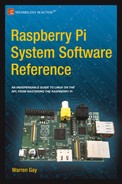Introduction
The Raspberry Pi, implemented as a System on a Chip (SoC), really does embody the very idea of a “system”. There are several large hardware components that make up this complex whole, that we call a system. When we then examine the software side that drives this hardware, we see another body of components that make up the operating system software.
As different as hardware is from software, they form a symbiotic relationship. The hardware provides for external interactions with the world while the software internalizes its inputs and determines the external actions that should result.
Content of this Book
This particular book is focused on system software aspects of the Raspberry Pi. The content was extracted from the complete volume “Mastering the Raspberry Pi” for those that want to focus on this area alone.
While the Pi is not restricted to running one operating system, this title assumes that the student will be working with Raspbian Linux. This is the platform supported by the Raspberry Pi Foundation and as a result, will represent the easiest path for learning.
Chapter 1 covers some very basic things that the beginning student may want to hit the ground running with. Things like setting up a static IP address, using ssh and VNC. Chapter two then jumps right into what happens when your Raspberry Pi boots. Files connected with booting and boot configuration is covered as a reference. But what happens after booting? Chapter 3 looks at how Raspbian Linux pulls itself up from its bootstraps. It examines how services get started and terminated.
Chapter 4 documents the vcgencmd command, which is unique to the Raspberry Pi. It reports and configures special aspects of the hardware. The Linux Console chapter covers the configuration of Linux consoles, including serial port consoles.
Chapters 6 and 7 are important to software developers of the Pi. The first is dedicated to the building and installing a cross-compiler environment for faster, more convenient development on fast hardware like your desktop system. For those that want to modify their Linux kernel, the last chapter is for you. This chapter will guide you through the steps needed to customize and build the Raspbian Linux kernel.
Assumptions about the Reader
Linux tends to be used as a catchall name to include more than just the kernel. In fact some people suggest that it should be referred to as GNU/Linux instead. This is because so much of the involved software is actually provided by the Free Software Foundation (FSF), aside from the Linux kernel. However you wish to frame it, the reader is assumed to either have some experience with Linux, or is developing some along the way.
For the section about Raspbian Linux initialization, knowledge of shell programming is an asset when creating or modifying the system startup procedures. Otherwise, a basic concept of Linux processes is sufficient for understanding.
Users of cross-compilers for application software development are expected to have some familiarity with the Linux developer tools. This includes the make command and the compiler/linker. Building the kernel can be done by the less experienced, but developer experience is an asset.
Working with the Raspberry Pi often results in bumping into a number of terms and acronyms like GPU or TCP. This book has assumed an intermediate to advanced level audience and consequently these terms are generally not explained. For readers encountering these terms for the first time, the Glossary in Appendix A is there to help.
Finally, as the end user installs or configures his Raspberry Pi, some of the example administration commands found in Appendix C may be useful as a cheat sheet. In most cases, the commands necessary will have already been presented in the text where needed. Mac OS X users will also find Mac specific tips in Appendix E.
